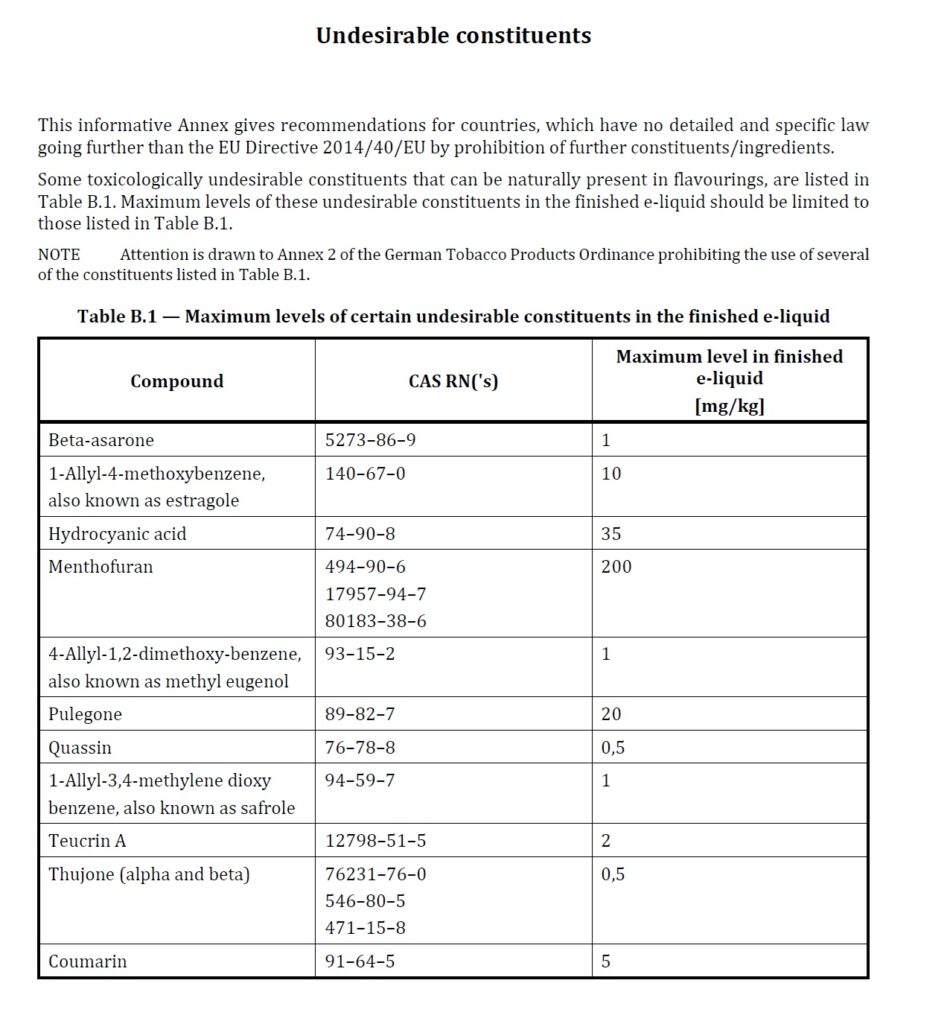EN – Which compounds are banned in e-liquids? (Part 1)
Let’s start with the facts – because facts are what I like the most.
In EU legislation, there are still no clear guidelines defining which compounds can – and which absolutely should not – be present in e-liquids.
Apart from the well-known nicotine limit (20 mg/ml) – there’s silence.
Fortunately, we can refer to the European standard EN 17648:2022, which specifies maximum levels of so-called “undesirable constituents” – compounds considered toxicologically undesirable in flavourings.
This information is especially important for manufacturers, as some of these substances may naturally occur in plant extracts or essential oils.
A few examples from the list:
Thujone (α and β) – max. 0.5 mg/kg
Pulegone – max. 20 mg/kg
Coumarin – max. 5 mg/kg
Methyl eugenol – max. 1 mg/kg
Estragole (1-allyl-4-methoxybenzene) – max. 10 mg/kg
It’s important to remember that these limits apply to the finished e-liquid, not to flavour concentrates or emission testing.
These numerical values serve as practical guidance for both laboratories and manufacturers, helping them defend their results in case of an “authority inspection” – and such inspections seem to be only a matter of time…
PL – Jakie związki są zakazane w e-liquidach? (Część 1)
Zacznijmy od konkretów – bo konkretne informacje to coś, co lubię najbardziej.
W polskim (ale nie tylko polskim) ustawodawstwie wciąż brakuje jasnych wytycznych, określających, jakie związki (a przede wszystkim w jakich stężeniach) mogą – a jakie absolutnie nie powinny – znajdować się w e-liquidach.
Poza dobrze znanym limitem nikotyny (20 mg/ml) – cisza.
Na szczęście z pomocą przychodzi europejska norma EN 17648:2022, która wskazuje maksymalne poziomy tzw. „undesirable constituents”, czyli niepożądanych składników aromatów.
To zestawienie jest szczególnie ważne dla producentów, bo część z tych związków może naturalnie występować w ekstraktach roślinnych lub olejkach eterycznych.
Kilka przykładów z listy:
Thujone (α i β) – max. 0,5 mg/kg
Pulegone – max. 20 mg/kg
Coumarin – max. 5 mg/kg
Methyl eugenol – max. 1 mg/kg
Estragole (1-allyl-4-methoxybenzene) – max. 10 mg/kg
Warto pamiętać, że limity te dotyczą gotowego e-liquidu, a nie samych aromatów czy badań emisji.
Konkretne wartości to wskazówki zarówno dla laboratoriów, jak i dla producentów – pozwalają się bronić w przypadku wykrycia ich podczas kontroli „urzędu” – a te kontrole wydają się być tylko kwestią czasu…



